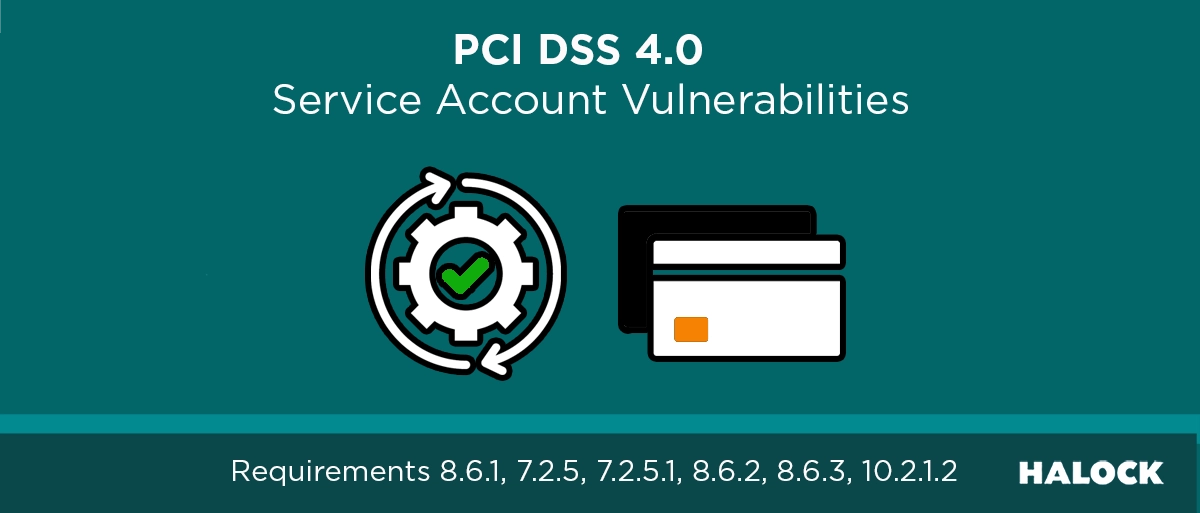While organizations rightly prioritize protecting employee accounts from cybersecurity threats, particularly those with elevated privileges, service accounts too often receive less attention despite their critical nature. Service accounts operate silently in the background, running critical business applications and services that are essential for operations.
The importance of securing service accounts is now formally recognized in PCI DSS v4.0.1, which introduces new requirements taking effect March 31, 2025. These automated accounts, though operating behind the scenes, can pose significant security risks if compromised.
What are Service Accounts in PCI DSS?
In PCI DSS compliance, application and system accounts, also referred to as “service accounts” are defined as accounts that execute processes or perform tasks on a computer system or in an application. These accounts usually have elevated privileges that are required to perform specialized tasks or functions and are not typically accounts used by an individual. The main difference between service and user accounts is that user accounts involve manual human interaction, and service accounts are used for automated services. Service accounts could be a web server account to process credit card transactions or an automated backup service that copies transaction logs.
Why is there a Requirement on Service Accounts?
In addition to the extensive privileges that service accounts often entail, their vulnerability extends beyond privilege levels for several key reasons:
- Critical System Access: Service accounts often have access to critical systems and data, making them prime targets for attackers seeking to gain deep access to an organization’s infrastructure.
- Lack of User Oversight: Unlike user accounts, which can be monitored and policed by the individual user, service accounts operate autonomously. Users can often identify suspicious activities on their own accounts, but service accounts lack human oversight.
- Password Stagnation: While users are regularly prompted to change their passwords, service account credentials are typically set at creation and rarely updated.
- Prolonged Compromise: Due to their background nature and infrequent monitoring, a compromised service account might remain undetected for an extended period, allowing attackers ample time to exploit the system.
What does PCI DSS v4.0.1 Require?
Service account management requires specific controls under PCI DSS v4.0.1 and multiple requirements will soon become mandatory. Define normal operating patterns for each service account, including typical usage times, systems accessed, and frequency of operations. Establishing service account compliance requires first documenting each account’s baseline operational patterns, including expected access times, system interactions, and operational frequency. Organizations should implement the principle of least privilege (PoLP) by restricting each service account’s permissions to only those resources necessary for its specific operational functions. Other requirements are outlined below.
Requirement 8.6.1 focuses on the management of accounts used by systems or applications that have the capability for interactive login. Each account capable of interactive login must be uniquely identified and authenticated to maintain accountability and the justification for their interactive use must be documented.
Requirement 7.2.5 and 7.2.5.1 mandates periodic reviews of all application and system account privileges. Organizations must establish review frequencies based on their risk analysis and implement formal policies and procedures for evaluating these accounts and their associated access rights.
Requirement 8.6.2 requires that organizations ensure that passwords/passphrases for any application and system accounts that can be used for interactive login are not hard coded in scripts, configuration/property files, or bespoke and custom source code.
Requirement 8.6.3 requires organizations to implement a process for rotating service account credentials on a schedule determined by their risk assessment. The requirement applies to all application and system accounts, regardless of whether they allow interactive login or not.
Requirement 10.2.1.2 pertains for logging and monitoring. It requires that all actions taken by service accounts must be logged, especially those with administrative privileges. Unfortunately, service accounts create a great deal of logging information as they are constantly starting and stopping processes so this can be challenging. Other requirements include:
- Logs generated by service account activities must be secured against unauthorized modifications or destruction.
- Organizations must retain audit log history for service account activities for at least 90 days, with a full year’s worth of logs available for analysis if needed
- Organizations must establish processes to identify unusual or unauthorized behavior from service accounts, such as unexpected access times
For organizations seeking help managing these requirements, HALOCK Security Labs can assist in providing comprehensive compliance assessments and implementation support. Our team can help evaluate your current service account controls and develop a roadmap to meet all PCI DSS v4.0.1 requirements for both service and user accounts.

